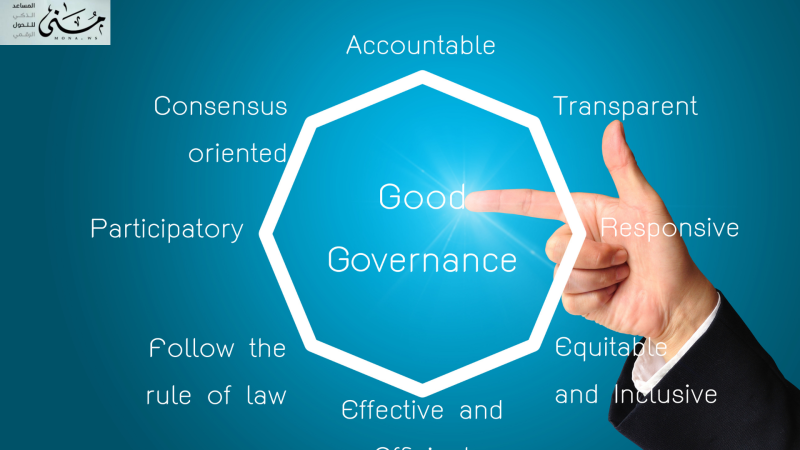Good governance has become an essential element for the success of organizations, as it ensures transparency, accountability, and efficiency in decision-making, while traditional governance focuses on management and organization. In this article, we will explain the difference between the two concepts, and discuss important statistics, implementation challenges, and the best digital systems to enhance governance in organizations.
What is governance and good governance?
Governance is an administrative concept that plays a pivotal role in controlling institutional performance and ensuring compliance with laws and standards. It aims to enhance transparency and accountability within institutions, whether governmental or private. As for wise governance, it is a more advanced development of the concept of governance, as it includes additional elements such as sustainability, empowering individuals, and involving stakeholders in the decision-making process, making it more comprehensive and influential.
At its core, governance focuses on setting the frameworks and rules that govern the relationship between the various parties within an organization, while good governance aims to ensure that these frameworks are used efficiently to achieve strategic objectives while taking into account the economic, social and environmental dimensions.
This highlights the importance of relying on advanced operations management systems, such as automation and smart management systems, which contribute to achieving sound governance standards on the ground.

Important statistics about governance and good governance
Studies show that organizations that apply good governance standards achieve stronger financial results and overall performance than their counterparts that rely on traditional management practices. According to a World Bank report, companies that adopt effective governance systems increase their ability to attract investment by up to 20% compared to companies with weak organizational structures.
At the country level, UN reports show that countries that implement good governance standards achieve 15-30% higher economic growth rates due to effective management of resources and directing investments towards sustainable development. On the other hand, research indicates that the absence of good governance can lead to the spread of corruption, which costs the global economy losses estimated at trillions of dollars annually.
The evolution of the concept of governance and the transition to good governance
The concept of governance has witnessed a significant development since its inception, as it initially focused only on regulatory aspects, such as compliance with laws and financial standards. With the increasing economic and political challenges, the focus began to shift towards good governance that is concerned with applying the principles of justice, transparency and sustainability in decision-making, which contributed to improving the performance of institutions and enhancing investor confidence.
In this context, the need has emerged for technological tools that help implement sound governance standards efficiently, including digital document management systems that facilitate auditing and oversight processes and improve institutional compliance. Today, large organizations rely on platforms such asDocSuite, which provides an integrated digital environment for document management, facilitating decision-making based on accurate and up-to-date information, and supporting the application of sound governance principles in modern institutions.
Challenges Facing the Implementation of Good Governance
Despite the clear benefits of good governance, there are major challenges that hinder the implementation of good governance in many institutions, most notably:
Resistance to changeSome traditional administrations have difficulty moving towards more transparent and fair systems due to entrenched customs and personal interests.
Weak digital infrastructureGood governance requires advanced technology platforms that support automation and transparency, which is a challenge in some countries and companies that lack these tools.
Lack of clarity in laws and regulationsIn some countries, legal systems may not be compatible with good governance standards, limiting their effectiveness.
The high cost of digital transformationDespite the significant benefits of good governance systems, the initial investment in digital transformation can be costly, especially for small and medium-sized enterprises.
In the face of these challenges, advanced technical solutions such as:DocSuite, Oracle GRC, or SAP GRC, each provides a secure and easy-to-use digital environment that supports the implementation of sound governance principles, helping organizations achieve their goals more efficiently and reduce the risks associated with traditional management.
The difference between governance and good governance is not limited to theoretical definitions, but is embodied in the actual practices and procedures adopted by institutions to enhance transparency, accountability and achieve sustainable development.
With technological advancements and the emergence of smart management platforms, implementing wise governance has become easier than ever, opening up new horizons for improving institutional performance and achieving economic and social sustainability.
Principles of good governance and its importance in modern institutions
Good governance is based on a set of basic principles that ensure effective management of institutions, whether governmental, private, or non-profit. The most important of these principles are:
Transparency: Providing clear and accurate information about corporate policies and decisions, so that all stakeholders can easily access them.
AccountabilityHolding executives and administrators accountable for their decisions, thus enhancing integrity and reducing corruption.
Efficiency and effectiveness: Ensuring that corporate operations are conducted in a manner that maximizes resource utilization, while achieving desired objectives.
Stakeholder engagement: Enhancing the participation of all stakeholders in decisions, including employees, customers, shareholders, and the community as a whole.
Rule of law: Applying laws and regulations fairly and without discrimination to ensure justice and institutional stability.
Sustainability: Making decisions that take into account environmental and social dimensions to ensure long-term sustainable development.
The difference between good governance and corporate governance
Although the two terms are similar, there are several differences to consider, namely:
|
The standard |
Good governance |
Corporate Governance |
|
Definition |
A set of principles and mechanisms to ensure fair and transparent decision-making in the public interest in governmental or public institutions. |
A set of policies and procedures that ensure companies are managed in a fair and transparent manner to serve shareholders and stakeholders. |
|
The field |
Government, public or non-profit institutions. |
Commercial and profitable companies. |
|
Objectives |
Promoting transparency, accountability and integrity in the public sector. |
Ensuring improved corporate performance, increased profits and protection of shareholders' rights. |
|
Stakeholders |
Government, citizens, regulatory bodies. |
Shareholders, Board of Directors, Executive Directors. |
|
the focus |
Achieving social justice and sustainable development. |
Achieving profitability and maximizing shareholder value. |
|
Mechanisms used |
Legislation, community oversight, government policies. |
Company internal regulations, financial market regulations, audit reports. |
|
Responsibility |
The government is primarily responsible for implementing the principles. |
The Board of Directors and Executive Directors are responsible for implementing the policies. |
Systems that serve good governance
There are many digital systems that help promote sound governance by improving transparency, regulatory compliance, risk management, and automating administrative processes. Here are some of the most important systems used globally:
DocSuite
It helps organizations manage electronic documents and correspondence in a secure and organized manner. It also provides an integrated system that ensures transparency, process tracking, and access control, and contributes to the automation of administrative workflow, which facilitates compliance with wise governance standards.
SAP Governance, Risk, and Compliance (SAP GRC)
It helps companies analyze risks and make data-driven decisions, and enables organizations to ensure compliance with laws and regulations.
Oracle Governance, Risk, and Compliance (Oracle GRC)
It provides advanced tools for managing governance, risk and compliance, and helps in analyzing financial and administrative data to detect any violations or risks.
In light of rapid economic and technological changes, good governance has become more important than ever. Organizations that apply good governance principles have a greater ability to grow and stabilize, and investors and customers prefer to deal with entities that operate according to clear standards that protect their rights and ensure sustainability.
 تهدف الحوكمة الرشيدة لتحقيق الأهداف الاستراتيجية للمؤسسات
تهدف الحوكمة الرشيدة لتحقيق الأهداف الاستراتيجية للمؤسسات











Comments
Add New Comment